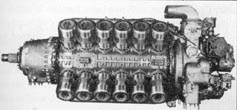
The Bristol Perseus was a British nine-cylinder, single-row, air-cooled radial aircraft engine produced by the Bristol Engine Company starting in 1932. It was the first production sleeve valve aero engine.

The Napier Sabre is a British H-24-cylinder, liquid-cooled, sleeve valve, piston aero engine, designed by Major Frank Halford and built by D. Napier & Son during World War II. The engine evolved to become one of the most powerful inline piston aircraft engines in the world, developing from 2,200 hp (1,600 kW) in its earlier versions to 3,500 hp (2,600 kW) in late-model prototypes.
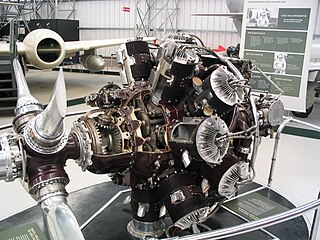
The Bristol Hercules is a 14-cylinder two-row radial aircraft engine designed by Sir Roy Fedden and produced by the Bristol Engine Company starting in 1939. It was the most numerous of their single sleeve valve designs, powering many aircraft in the mid-World War II timeframe.

The Centaurus was the final development of the Bristol Engine Company's series of sleeve valve radial aircraft engines. The Centaurus is an 18-cylinder, two-row design that eventually delivered over 3,000 hp (2,200 kW). The engine was introduced into service late in the Second World War and was one of the most powerful aircraft piston engines to see service.
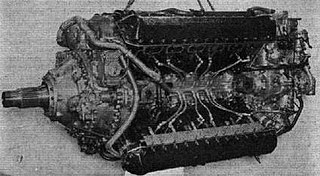
The Rolls-Royce Vulture was a British aero engine developed shortly before World War II that was designed and built by Rolls-Royce Limited. The Vulture used the unusual "X-24" configuration, whereby four cylinder blocks derived from the Rolls-Royce Peregrine were joined by a common crankshaft supported by a single crankcase. The engine was originally designed to produce around 1,750 horsepower (1,300 kW) but problems with the Vulture design meant that the engines were derated to around 1,450 to 1,550 hp in service by limiting the maximum rpm.

The Packard V-1650 Merlin is a version of the Rolls-Royce Merlin aircraft engine, produced under license in the United States by the Packard Motor Car Company. The engine was licensed to expand production of the Rolls-Royce Merlin for British use. The engine also filled a gap in the U.S. at a time when similarly powered American-made engines were not available.
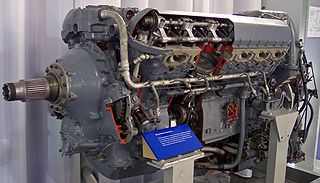
The Rolls-Royce Griffon is a British 37-litre capacity, 60-degree V-12, liquid-cooled aero engine designed and built by Rolls-Royce Limited. In keeping with company convention, the Griffon was named after a bird of prey, in this case the griffon vulture.
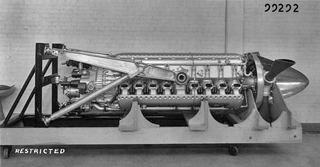
The Chrysler XIV-2220 was an experimental 2,500 hp, 2,220 cubic inch liquid-cooled inverted-V-16 aircraft engine designed by Chrysler starting in 1940. Although several aircraft designs had considered using it, by the time it was ready for use in 1945 the war was already over. Only a few engines were built during the program, and it retained its 'X' designation the entire time as the XIV-2220, later XI-2220. The IV-2220 is historically important as it was Chrysler's first hemi, a design that would re-appear for many years later and is now a Chrysler trademark.

The Rolls-Royce Peregrine was a 21-litre (1,300 cu in), 885-horsepower (660 kW) liquid-cooled V-12 aero engine designed and built by the British manufacturer Rolls-Royce in the late 1930s. It was essentially the ultimate development of the company's Kestrel engine, which had seen widespread use in military aircraft of the pre-war period.

The Kestrel or type F is a 21 litre 700 horsepower (520 kW) class V-12 aircraft engine from Rolls-Royce, their first cast-block engine and the pattern for most of their future piston-engine designs. Used during the interwar period, it provided excellent service on a number of British fighters and bombers of the era, such as the Hawker Fury and Hawker Hart family, and the Handley Page Heyford. The engine also sold to international air forces, and it was even used to power prototypes of German military aircraft types that were later used during the Battle of Britain. Several Kestrel engines remain airworthy today.
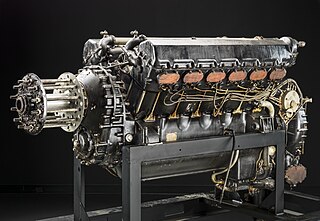
The Rolls-Royce Buzzard was a British piston aero engine of 36.7 litres capacity that produced about 800 horsepower (600 kW). Designed and built by Rolls-Royce Limited it is a V12 engine of 6 in (150 mm) Bore and 6.6 in (170 mm) Stroke. Only 100 were made. A further development was the Rolls-Royce R engine. The Buzzard was developed by scaling-up the Rolls-Royce Kestrel Engine.

The Rolls-Royce Eagle was the first aircraft engine to be developed by Rolls-Royce Limited. Introduced in 1915 to meet British military requirements during World War I, it was used to power the Handley Page Type O bombers and a number of other military aircraft.

The Rolls-Royce Eagle Mk XXII is a British 24-cylinder, sleeve valve, H-block aero engine of 46 litre displacement. It was designed and built in the early-1940s by Rolls-Royce Limited and first ran in 1944. It was liquid-cooled, of flat H configuration with two crankshafts and was capable of 3,200 horsepower at 18 psi boost.

The Rolls-Royce Crecy was a British experimental two-stroke, 90-degree, V12, liquid-cooled aero-engine of 1,593.4 cu.in capacity, featuring sleeve valves and direct petrol injection. Initially intended for a high-speed "sprint" interceptor fighter, the Crecy was later seen as an economical high-altitude long-range powerplant. Developed between 1941 and 1946, it was among the most advanced two-stroke aero-engines ever built. The engine never reached flight trials and the project was cancelled in December 1945, overtaken by the progress of jet engine development.

The Klimov VK-107 was a V-12 liquid-cooled piston aircraft engine used by Soviet aircraft during World War II.
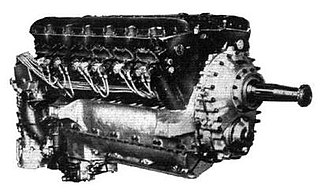
The Rolls-Royce Goshawk was a development of the Rolls-Royce Kestrel that used evaporative or steam cooling. In line with Rolls-Royce convention of naming piston engines after birds of prey, it was named after the goshawk.

The Allison V-3420 was a large experimental piston aircraft engine, designed in 1937 by the American Allison Engine Company.

The Rolls-Royce Exe, or Boreas, was a 24-cylinder air-cooled X block sleeve valve aircraft engine intended primarily for the new Fairey Fleet Air Arm aircraft, particularly the Fairey Barracuda. The Exe was relatively powerful for its era, producing about 1,100 hp (820 kW). This is notable given the relatively small 1,300 cubic inches (22 L) displacement, the Merlin requiring 1,600 cubic inches (27 L) for approximately the same power level. The X-24 layout made this quite a compact engine.
The Rolls-Royce Eagle XVI was a British experimental 16 cylinder aero engine designed and developed by Rolls-Royce Limited in 1925. The engine was test run but did not fly, the project, together with the planned larger variant, the Eagle XX, was cancelled in favour of the Rolls-Royce Kestrel, that was being developed concurrently.

The Fiat AS.6 was an unusual Italian 24-cylinder, liquid-cooled V configured aircraft racing engine designed and built in the late-1920s by Fiat especially for the Schneider Trophy air races, but development and running problems meant that it was never able to compete. Although the engine suffered from technical problems, it was later used to set a speed record for piston-powered seaplanes that still stands today.
